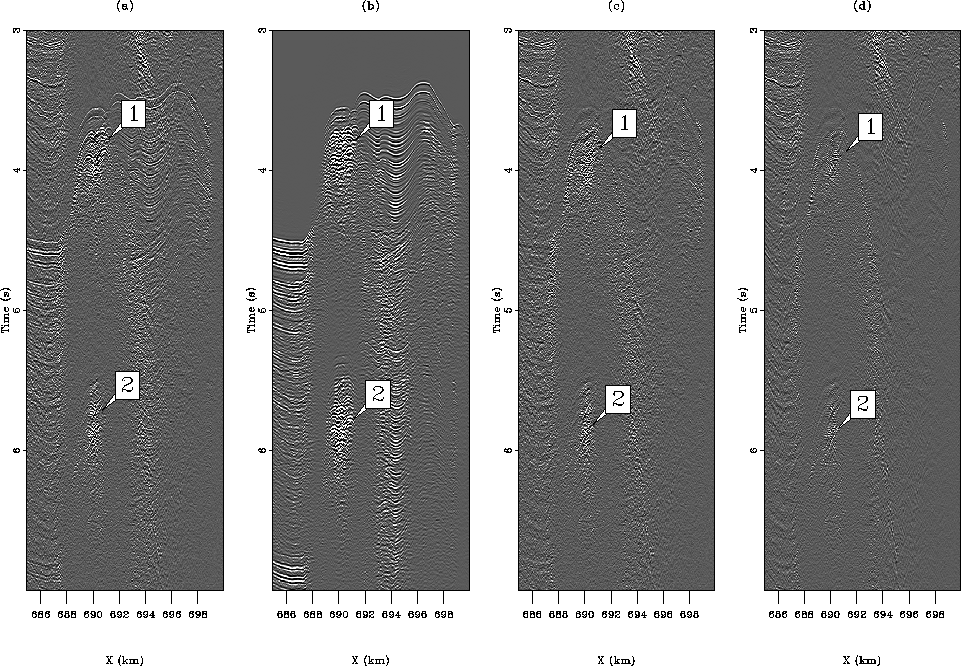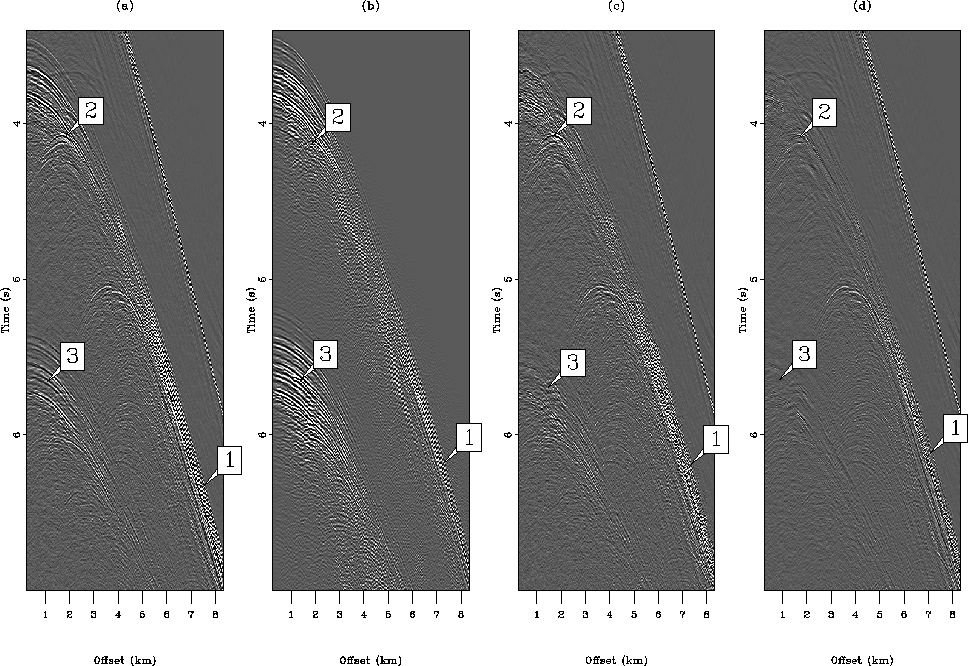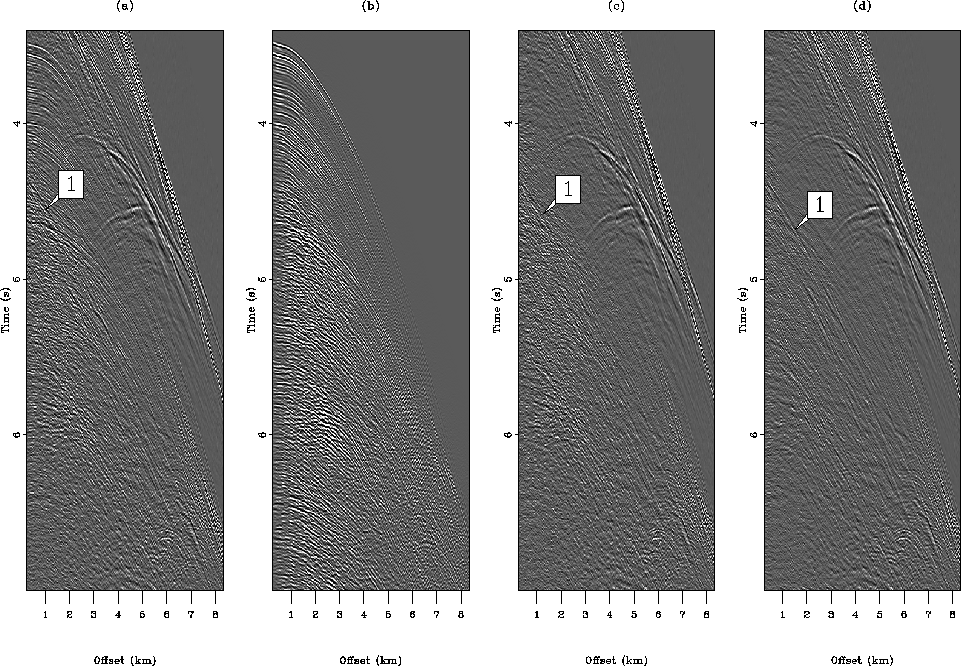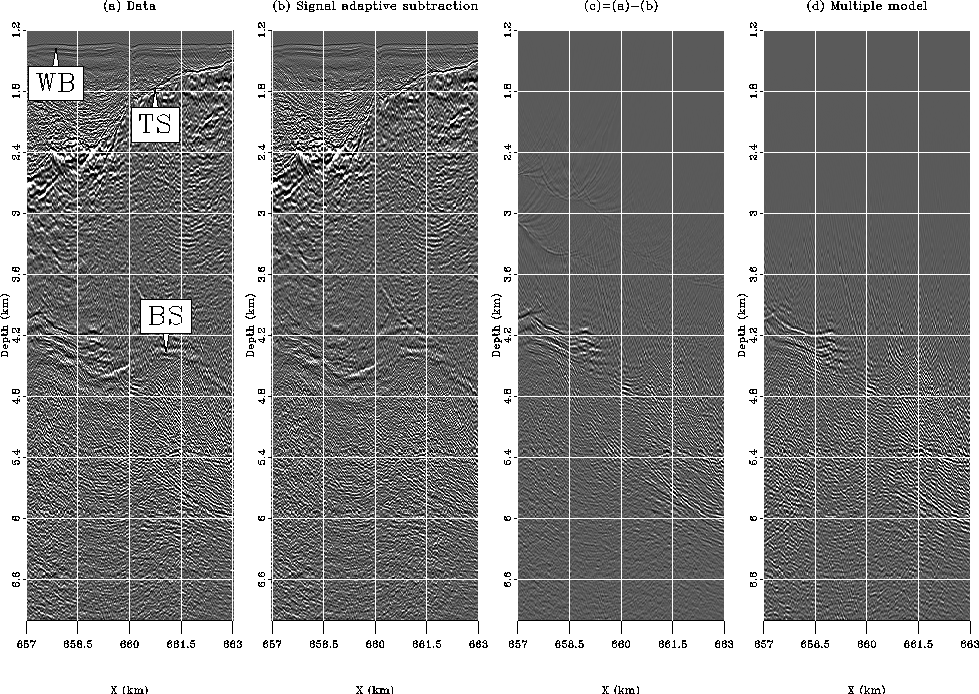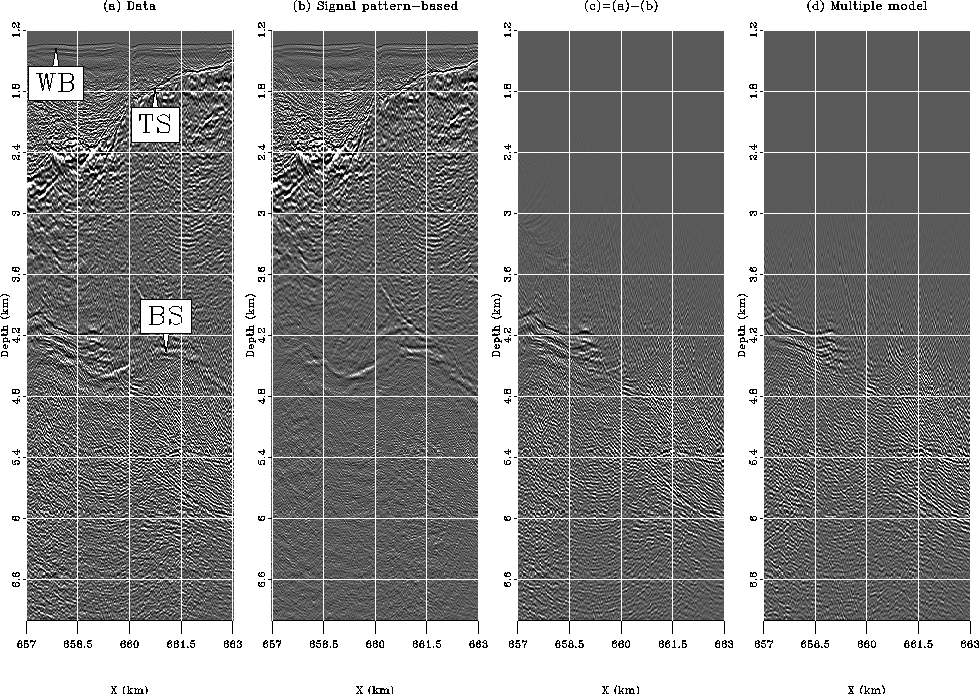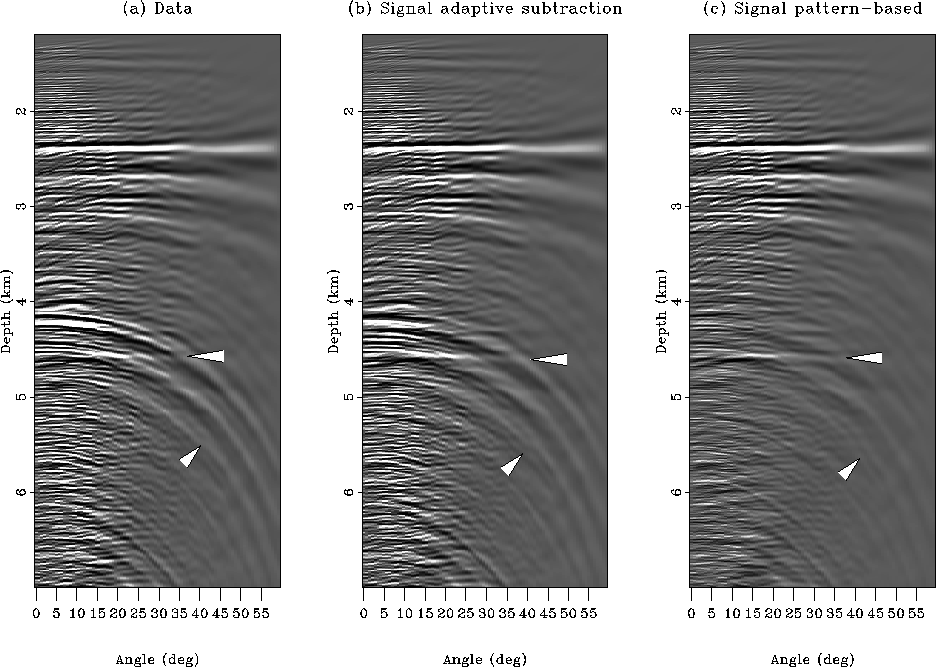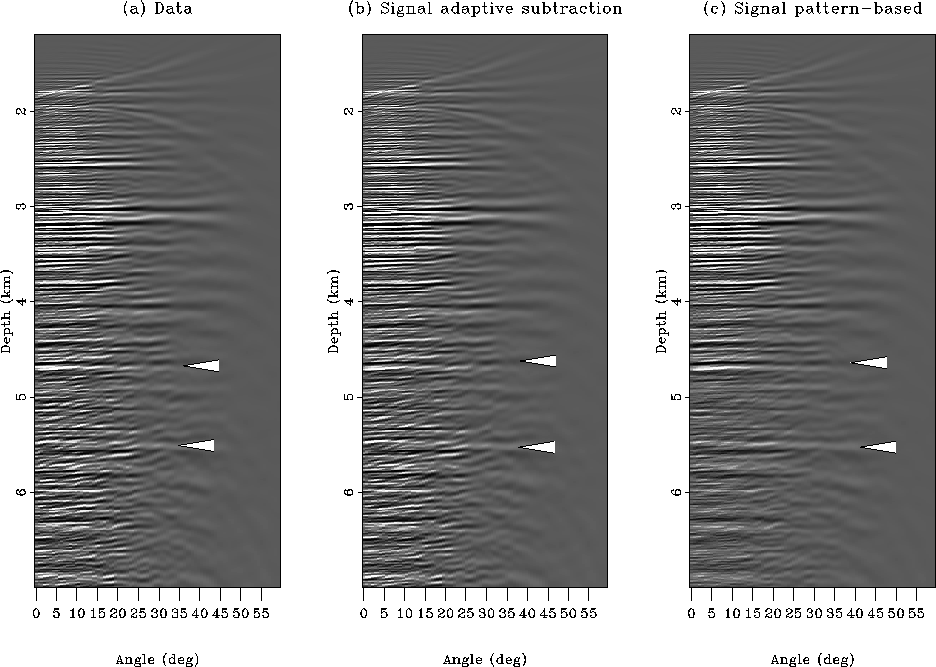




Next: Discussion
Up: Multiple subtraction
Previous: Comparing the two methods
For this dataset, the choice of parameters such as filter sizes,
patch sizes, number of iterations and Lagrange multipliers (e.g.,
 in equation (
in equation (![[*]](http://sepwww.stanford.edu/latex2html/cross_ref_motif.gif) )) was
determined by trial and error on small portions of the data for both
methods. Experience shows that the Lagrange multipliers are the only
parameters to be changed from one dataset to another.
)) was
determined by trial and error on small portions of the data for both
methods. Experience shows that the Lagrange multipliers are the only
parameters to be changed from one dataset to another.
Prestack results are presented in Figures ![[*]](http://sepwww.stanford.edu/latex2html/cross_ref_motif.gif) ,
,
![[*]](http://sepwww.stanford.edu/latex2html/cross_ref_motif.gif) , and
, and ![[*]](http://sepwww.stanford.edu/latex2html/cross_ref_motif.gif) where panel (a)
displays the input data, (b) the multiple model, (c) the estimated
primaries with adaptive subtraction, and (d) the estimated primaries
with the pattern-based approach. Figure
where panel (a)
displays the input data, (b) the multiple model, (c) the estimated
primaries with adaptive subtraction, and (d) the estimated primaries
with the pattern-based approach. Figure ![[*]](http://sepwww.stanford.edu/latex2html/cross_ref_motif.gif) displays a constant offset section at 500 m offset. The arrows in 1 and 2 point
to locations where the multiple model is not accurate. At these
locations, the pattern-based approach attenuates the multiples better
than adaptive subtraction. Figure
displays a constant offset section at 500 m offset. The arrows in 1 and 2 point
to locations where the multiple model is not accurate. At these
locations, the pattern-based approach attenuates the multiples better
than adaptive subtraction. Figure ![[*]](http://sepwww.stanford.edu/latex2html/cross_ref_motif.gif) displays
multiple removal results for one shot gather (X=664 km). Arrow 1 shows an
area where the multiples are poorly predicted and poorly attenuated by
both methods. At this location, the pattern-based techniques
attenuates more multiples, however. Arrow 2 points to a diffracted event
that is present in the multiple model but slightly shifted in time
and offset. The adaptive subtraction is unable to remove this event
while the pattern-based technique attenuates it. Arrow 3 shows another
location where the multiples are better attenuated with the
pattern-based approach. Note that some multiples, especially
diffracted multiples, are still present in the estimated primaries
because these events are totally absent in the model. Finally,
Figure
displays
multiple removal results for one shot gather (X=664 km). Arrow 1 shows an
area where the multiples are poorly predicted and poorly attenuated by
both methods. At this location, the pattern-based techniques
attenuates more multiples, however. Arrow 2 points to a diffracted event
that is present in the multiple model but slightly shifted in time
and offset. The adaptive subtraction is unable to remove this event
while the pattern-based technique attenuates it. Arrow 3 shows another
location where the multiples are better attenuated with the
pattern-based approach. Note that some multiples, especially
diffracted multiples, are still present in the estimated primaries
because these events are totally absent in the model. Finally,
Figure ![[*]](http://sepwww.stanford.edu/latex2html/cross_ref_motif.gif) displays a shot gather where the
multiple attenuation worked well for both techniques. This gather
(X=693 km) comes from an area where the acquisition geometry and
the geology are the most appropriate for the 2-D prediction, which
explains why both techniques work very well. Arrow 1 points to one event
that is still better preserved with the pattern-based method.
displays a shot gather where the
multiple attenuation worked well for both techniques. This gather
(X=693 km) comes from an area where the acquisition geometry and
the geology are the most appropriate for the 2-D prediction, which
explains why both techniques work very well. Arrow 1 points to one event
that is still better preserved with the pattern-based method.
window1-signal
Figure 12 A constant offset
section at 500 m offset for (a) the input data, (b) the multiple model,
(c) the estimated primaries with adaptive subtraction, and (d) the
estimated primaries with the pattern-based approach.
The horizontal axis represents the midpoint position. 1 and 2 points
to area where the multiples are not accurately predicted and where
the pattern-based approach performs better than adaptive
subtraction.




 window3-signal
window3-signal
Figure 13 A shot gather (X=664
km) for (a) the input data, (b) the multiple model,
(c) the estimated primaries with adaptive subtraction, and (d) the
estimated primaries with the pattern-based approach. 1 shows
multiples that are not properly predicted and not completely
removed. 2 shows an event that is predicted at the wrong location
but still attenuated in (d). 3 shows an area where the pattern-based
approach attenuates more multiples than adaptive subtraction.




 window4-signal
window4-signal
Figure 14 A shot gather (X=693
km) for (a) the input data, (b) the multiple model,
(c) the estimated primaries with adaptive subtraction, and (d) the
estimated primaries with the pattern-based approach. 1 points to a
primary that is better preserved in (d).





Now, the data and the estimated primaries for both subtraction
techniques are migrated with a split-step double
square-root (DSR) migration algorithm (see Chapter ![[*]](http://sepwww.stanford.edu/latex2html/cross_ref_motif.gif) ).
Figures
).
Figures ![[*]](http://sepwww.stanford.edu/latex2html/cross_ref_motif.gif) and
and ![[*]](http://sepwww.stanford.edu/latex2html/cross_ref_motif.gif) show a
comparison of the migrated data (shown in (a)), the estimated
primaries (shown in (b)), the estimated multiples (shown in (c)),
and the multiple model from SRMP (shown in (d)) for the adaptive
and pattern-based subtraction techniques, respectively.
These results are close-ups of a sedimentary basin.
The pattern-based approach (Figure
show a
comparison of the migrated data (shown in (a)), the estimated
primaries (shown in (b)), the estimated multiples (shown in (c)),
and the multiple model from SRMP (shown in (d)) for the adaptive
and pattern-based subtraction techniques, respectively.
These results are close-ups of a sedimentary basin.
The pattern-based approach (Figure ![[*]](http://sepwww.stanford.edu/latex2html/cross_ref_motif.gif) b)
yields cleaner multiple-free panels. In addition, the
multiples inside the circle are better attenuated with the
pattern-based approach than with the adaptive-subtraction
technique (Figure
b)
yields cleaner multiple-free panels. In addition, the
multiples inside the circle are better attenuated with the
pattern-based approach than with the adaptive-subtraction
technique (Figure ![[*]](http://sepwww.stanford.edu/latex2html/cross_ref_motif.gif) b). One reason
for these differences comes from the modeling inaccuracies
of 2-D SRMP, as exemplified in Figures
b). One reason
for these differences comes from the modeling inaccuracies
of 2-D SRMP, as exemplified in Figures ![[*]](http://sepwww.stanford.edu/latex2html/cross_ref_motif.gif) c
and
c
and ![[*]](http://sepwww.stanford.edu/latex2html/cross_ref_motif.gif) c. There, it appears that modeled multiples
do not match the true multiples in the migrated data exactly (e.g., Figure
c. There, it appears that modeled multiples
do not match the true multiples in the migrated data exactly (e.g., Figure
![[*]](http://sepwww.stanford.edu/latex2html/cross_ref_motif.gif) a). The pattern-based approach is able to cope
better with the differences between true and modeled multiples.
a). The pattern-based approach is able to cope
better with the differences between true and modeled multiples.
Now, Figures ![[*]](http://sepwww.stanford.edu/latex2html/cross_ref_motif.gif) and
and ![[*]](http://sepwww.stanford.edu/latex2html/cross_ref_motif.gif) display multiple attenuation results in the presence of a salt
body. Again, the base of salt reflection is cleaner and
more continuous with the pattern-based approach
(Figure
display multiple attenuation results in the presence of a salt
body. Again, the base of salt reflection is cleaner and
more continuous with the pattern-based approach
(Figure ![[*]](http://sepwww.stanford.edu/latex2html/cross_ref_motif.gif) b) than with adaptive subtraction
(Figure
b) than with adaptive subtraction
(Figure ![[*]](http://sepwww.stanford.edu/latex2html/cross_ref_motif.gif) b). Figures
b). Figures ![[*]](http://sepwww.stanford.edu/latex2html/cross_ref_motif.gif) d
and
d
and ![[*]](http://sepwww.stanford.edu/latex2html/cross_ref_motif.gif) d show the migrated multiple model. The model
exhibits important kinematic differences with the true multiples. For
instance, the water-bottom multiple at 4.2 km is slightly shifted
horizontally in the model. The pattern-based approach is able to
remove this multiple albeit modeling errors.
d show the migrated multiple model. The model
exhibits important kinematic differences with the true multiples. For
instance, the water-bottom multiple at 4.2 km is slightly shifted
horizontally in the model. The pattern-based approach is able to
remove this multiple albeit modeling errors.
mig_adaptive
Figure 15 Migrated images
for (a) the data, (b) the estimated primaries with adaptive
subtraction, (c) the difference between (a) and (b), i.e., the
estimated multiples, and (d) the multiple model with SRMP.
Multiples in the circle are not well attenuated.




 mig_pattern
mig_pattern
Figure 16 Migrated images
for (a) the data, (b) the estimated primaries with the pattern-based
approach, (c) the difference between (a) and (b), i.e., the
estimated multiples, and (d) the multiple model with SRMP.
Multiples in the circle are better attenuated
in (b) than in Figure ![[*]](http://sepwww.stanford.edu/latex2html/cross_ref_motif.gif) b. In addition, the primaries
look more continuous everywhere.
b. In addition, the primaries
look more continuous everywhere.




 mig_adaptive1
mig_adaptive1
Figure 17 Migrated images
for (a) the data, (b) the estimated primaries with adaptive
subtraction, (c) the difference between (a) and (b), i.e., the
estimated multiples, and (d) the multiple model with SRMP.
The base of salt is indicated by an arrow in (a).
Some subsalt multiples are still present. Arrow WB shows the water
bottom, TS the top of salt, and BS the base of salt.




 mig_pattern1
mig_pattern1
Figure 18 Migrated images
for (a) the data, (b) the estimated primaries with the pattern-based
approach, (c) the difference between (a) and (b), i.e., the
estimated multiples, and (d) the multiple model with SRMP.
The base of salt is better preserved than in
Figure ![[*]](http://sepwww.stanford.edu/latex2html/cross_ref_motif.gif) b and the subsalt multiples are
well attenuated. Arrow WB shows the water
bottom, TS the top of salt, and BS the base of salt.
b and the subsalt multiples are
well attenuated. Arrow WB shows the water
bottom, TS the top of salt, and BS the base of salt.





Finally, angle-domain common image gathers (ADCIG) are created
with the method of Sava and Fomel (2003) after migration
Stolt and Weglein (1985); Weglein and Stolt (1999). Figures ![[*]](http://sepwww.stanford.edu/latex2html/cross_ref_motif.gif) a,
a,
![[*]](http://sepwww.stanford.edu/latex2html/cross_ref_motif.gif) b, and
b, and ![[*]](http://sepwww.stanford.edu/latex2html/cross_ref_motif.gif) c show three ADCIG for the data,
the estimated primaries with adaptive subtraction, and the estimated
primaries with the pattern-based approach, respectively. This ADCIG is located
within the salt boundaries. The primary at 4.6 s. is the base of salt reflection.
Events with large curvatures in Figure
c show three ADCIG for the data,
the estimated primaries with adaptive subtraction, and the estimated
primaries with the pattern-based approach, respectively. This ADCIG is located
within the salt boundaries. The primary at 4.6 s. is the base of salt reflection.
Events with large curvatures in Figure ![[*]](http://sepwww.stanford.edu/latex2html/cross_ref_motif.gif) b are
multiples. Again, the pattern-based approach produces a better panel.
The method of Sava and Guitton (2005) could be used to remove
the remaining multiples with a Radon-based technique. As a final
example, Figure
b are
multiples. Again, the pattern-based approach produces a better panel.
The method of Sava and Guitton (2005) could be used to remove
the remaining multiples with a Radon-based technique. As a final
example, Figure ![[*]](http://sepwww.stanford.edu/latex2html/cross_ref_motif.gif) show a comparison of ADCIGs outside the
salt body, within the sedimentary basin of Figures
show a comparison of ADCIGs outside the
salt body, within the sedimentary basin of Figures
![[*]](http://sepwww.stanford.edu/latex2html/cross_ref_motif.gif) and
and ![[*]](http://sepwww.stanford.edu/latex2html/cross_ref_motif.gif) . The primaries are
more continuous and better preserved with the pattern-based approach
(Figure
. The primaries are
more continuous and better preserved with the pattern-based approach
(Figure ![[*]](http://sepwww.stanford.edu/latex2html/cross_ref_motif.gif) b) than with adaptive subtraction (Figure
b) than with adaptive subtraction (Figure ![[*]](http://sepwww.stanford.edu/latex2html/cross_ref_motif.gif) c).
c).
ang1
Figure 19 ADCIG at X=658.975 for (a) the data, (b)
the estimated primaries with adaptive subtraction, and (c) the
estimated primaries with the pattern-based approach. The arrow at 4.6
s. shows the base of salt reflection. The second arrow shows multiples
at high angles with strong curvatures. The pattern-based approach
yields a cleaner gather.




 ang2
ang2
Figure 20 ADCIG at X=674.325 for (a) the data, (b)
the estimated primaries with adaptive subtraction, and (c) the
estimated primaries with the pattern-based approach. The two arrows
show primaries that are more continuous after pattern-based
subtraction of the multiples.










Next: Discussion
Up: Multiple subtraction
Previous: Comparing the two methods
Stanford Exploration Project
5/5/2005
![[*]](http://sepwww.stanford.edu/latex2html/cross_ref_motif.gif) ,
,
![[*]](http://sepwww.stanford.edu/latex2html/cross_ref_motif.gif) , and
, and ![[*]](http://sepwww.stanford.edu/latex2html/cross_ref_motif.gif) where panel (a)
displays the input data, (b) the multiple model, (c) the estimated
primaries with adaptive subtraction, and (d) the estimated primaries
with the pattern-based approach. Figure
where panel (a)
displays the input data, (b) the multiple model, (c) the estimated
primaries with adaptive subtraction, and (d) the estimated primaries
with the pattern-based approach. Figure ![[*]](http://sepwww.stanford.edu/latex2html/cross_ref_motif.gif) displays a constant offset section at 500 m offset. The arrows in 1 and 2 point
to locations where the multiple model is not accurate. At these
locations, the pattern-based approach attenuates the multiples better
than adaptive subtraction. Figure
displays a constant offset section at 500 m offset. The arrows in 1 and 2 point
to locations where the multiple model is not accurate. At these
locations, the pattern-based approach attenuates the multiples better
than adaptive subtraction. Figure ![[*]](http://sepwww.stanford.edu/latex2html/cross_ref_motif.gif) displays
multiple removal results for one shot gather (X=664 km). Arrow 1 shows an
area where the multiples are poorly predicted and poorly attenuated by
both methods. At this location, the pattern-based techniques
attenuates more multiples, however. Arrow 2 points to a diffracted event
that is present in the multiple model but slightly shifted in time
and offset. The adaptive subtraction is unable to remove this event
while the pattern-based technique attenuates it. Arrow 3 shows another
location where the multiples are better attenuated with the
pattern-based approach. Note that some multiples, especially
diffracted multiples, are still present in the estimated primaries
because these events are totally absent in the model. Finally,
Figure
displays
multiple removal results for one shot gather (X=664 km). Arrow 1 shows an
area where the multiples are poorly predicted and poorly attenuated by
both methods. At this location, the pattern-based techniques
attenuates more multiples, however. Arrow 2 points to a diffracted event
that is present in the multiple model but slightly shifted in time
and offset. The adaptive subtraction is unable to remove this event
while the pattern-based technique attenuates it. Arrow 3 shows another
location where the multiples are better attenuated with the
pattern-based approach. Note that some multiples, especially
diffracted multiples, are still present in the estimated primaries
because these events are totally absent in the model. Finally,
Figure ![[*]](http://sepwww.stanford.edu/latex2html/cross_ref_motif.gif) displays a shot gather where the
multiple attenuation worked well for both techniques. This gather
(X=693 km) comes from an area where the acquisition geometry and
the geology are the most appropriate for the 2-D prediction, which
explains why both techniques work very well. Arrow 1 points to one event
that is still better preserved with the pattern-based method.
displays a shot gather where the
multiple attenuation worked well for both techniques. This gather
(X=693 km) comes from an area where the acquisition geometry and
the geology are the most appropriate for the 2-D prediction, which
explains why both techniques work very well. Arrow 1 points to one event
that is still better preserved with the pattern-based method.
